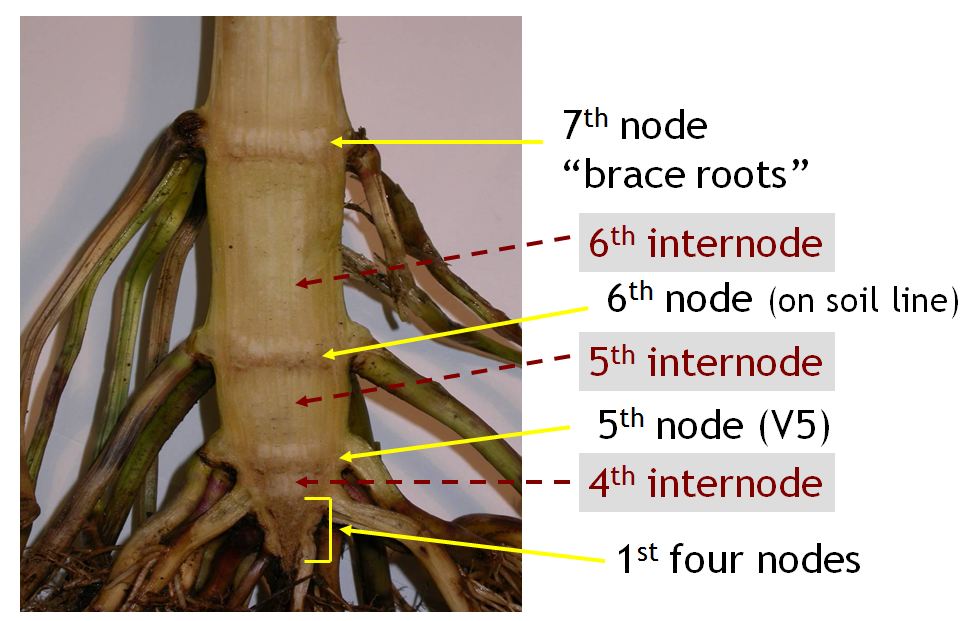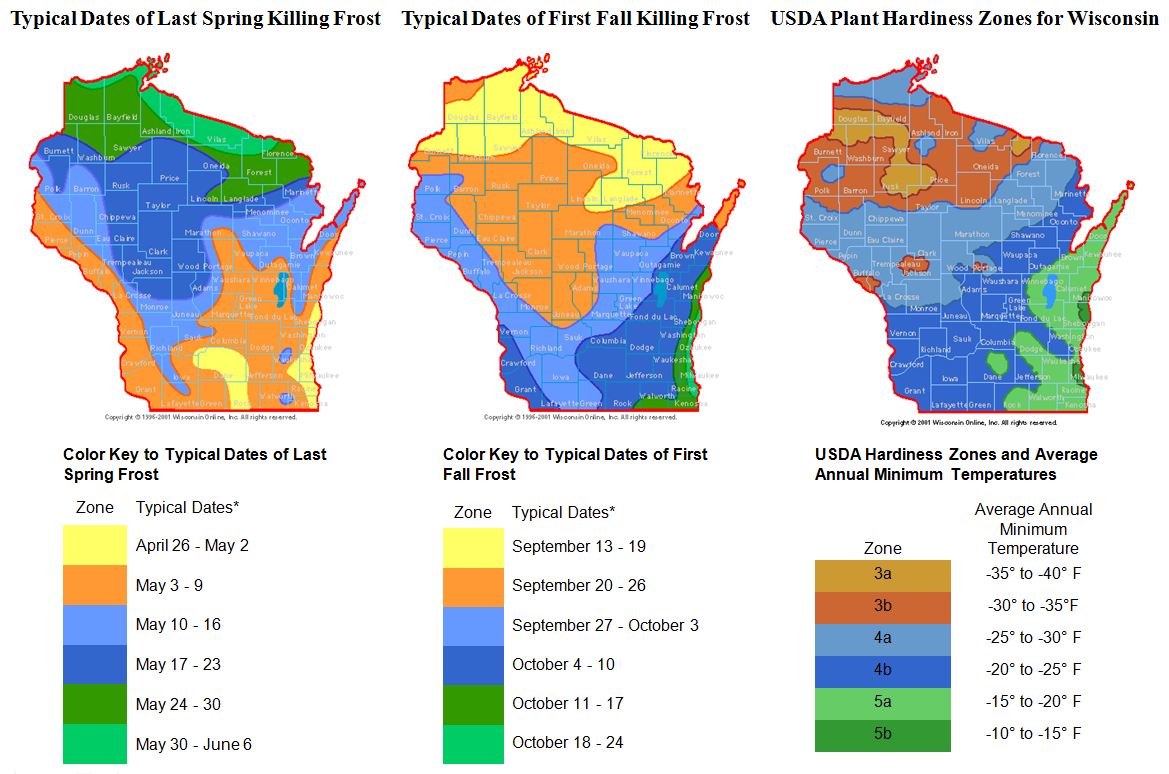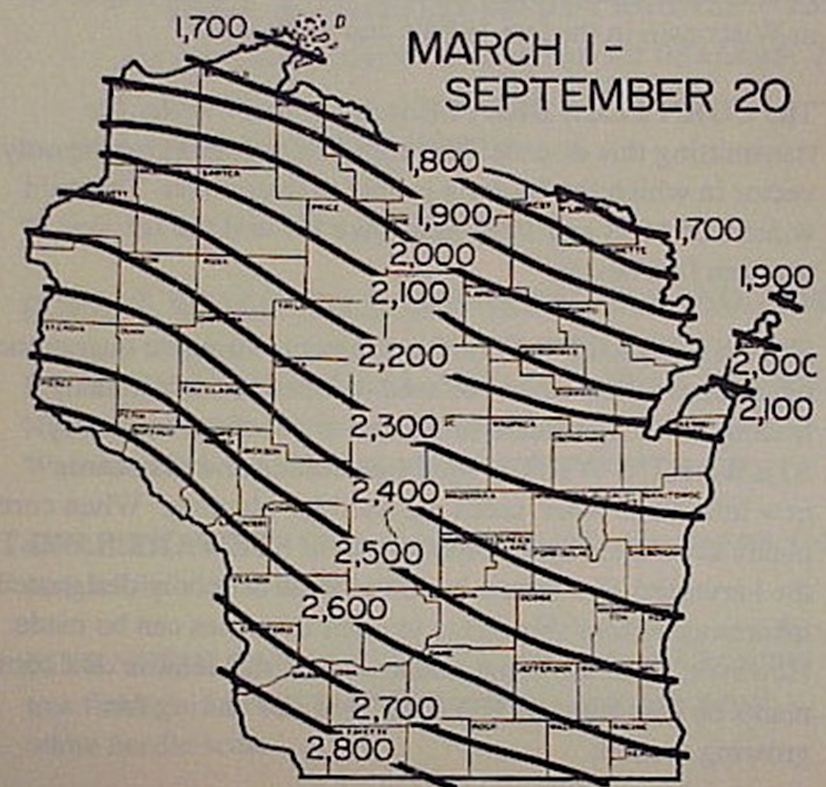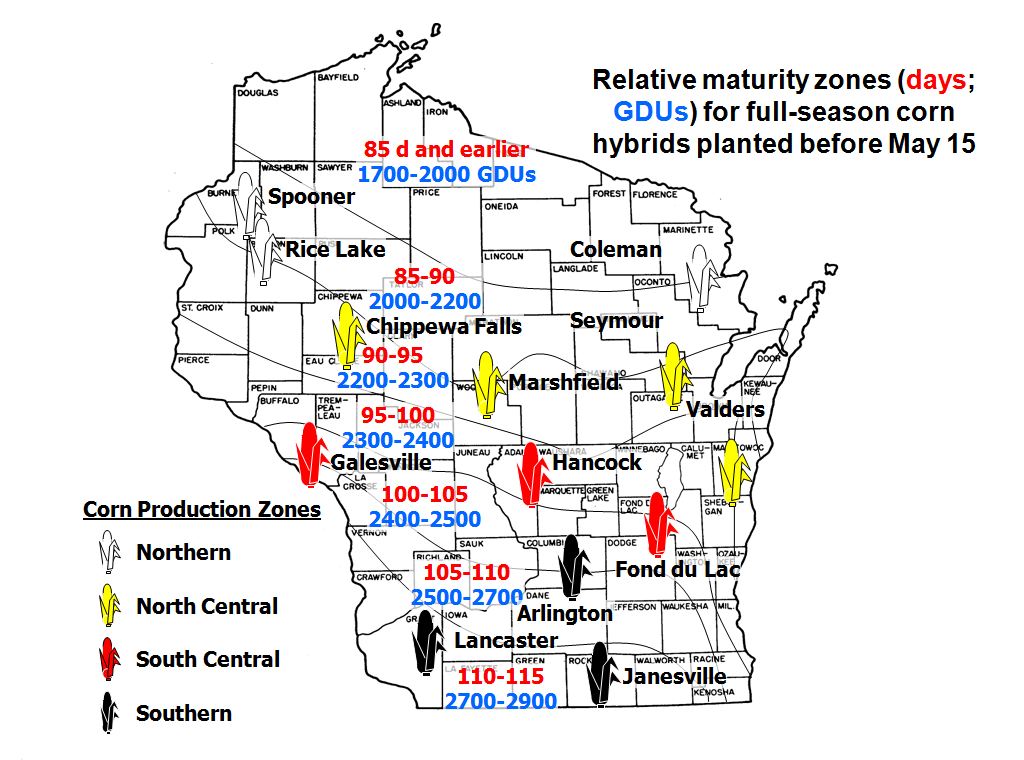Corn Development
Originally written February 1, 2006 | Last updated
August 07, 2016
The corn plant is one of nature's most amazing energy storing devices. It does
this by producing a large efficient energy "factory" - the plant with
its roots, leaves, stalk, and flowering parts - and then by capturing the sun's
energy and storing large amounts of this energy in the grain, in a chemical form
(largely starch) that can be used as an energy source by animals.
Nature provides the major portion of the environmental influence on corn growth
and yields. However, the corn producer can manipulate the environment with managerial
operations including hybrid selection, soil tillage, crop rotation, soil fertilization,
irrigation, and pest control. A producer who understands the growth and development
of corn can use production practices to obtain higher yields and profit by being
more efficient and timely.
A producer who understands the corn plant can use production practices more
efficiently and timely to obtain higher yields and profits.
Identifying Stages of Development
 How a corn plant develops - Iowa State University Special Report
No. 48
How a corn plant develops - Iowa State University Special Report
No. 48
Corn Growth
and Development & Management Information for Replant Decisions
University of Minnesota FO-5700-GO
Maize Growth and Development University of Illinois
Corn
Growth and Development poster. Order
here.
The staging system most commonly used is the Iowa System. It divides plant development
into vegetative (V) and reproductive (R) stages (Table 1.). Subdivisions of the
V stages are designated numerically as V1, V2, V3, through Vn, where n represents
the last stage before VT (tasseling). The six subdivisions of the reproductive stages
are designated numerically.
|
Vegetative Stages
|
Reproductive stages
|
VE Emergence
V1 First leaf collar
V2 Second leaf collar
V3 Third leaf collar
.
.
.
VT Tasseling
|
R1 Silking
R2 Blister
R3 Milk
R4 Dough
R5 Dent
R6 Black layer (Physiological maturity)
|
Each leaf stage is defined according to the uppermost leaf whose collar is
visible.

Beginning at about V6, increasing stalk and nodal root growth combine to tear
the small lowest leaves from the plant. To determine the leaf stage after lower
leaf loss, split the lower stalk lengthwise and inspect for internode elongation.
The first node above the first elongated stalk internode generally is the fifth
leaf node. The internode usually is about one centimeter in length. This fifth leaf
node may be used as a replacement reference point for counting to the top leaf collar.

In a corn field all plants will not be in the same stage at the same time.
Each specific V or R stage is defined only when 50% or more of the plants in the
filed are in or beyond that stage.
Although each stage of development is critical for proper corn production
we will focus on VE, V6, V12, V18, R1, and R6. Table 2 describes the yield components
being determined at each growth stage.
|
Corn growth and development stages when yield components are determined
|
Growth
Stage
|
|
Yield components
|
|
GDU
|
Potential
|
Actual
|
|
VE
|
125
|
Ears/area
|
-----
|
|
V6
|
470
|
Kernel rows/ear
|
"Factory"
|
|
V12
|
815
|
-----
|
Kernel rows/ear
|
|
V18
|
1160
|
Kernels/row
|
-----
|
|
R1
|
1250
|
Kernel weight
|
Kernel number Ears/area
|
|
R6
|
2350
|
-----
|
Kernel weight
|
Much of the following is a synopsis of the publication entitled "How
a corn plant develops" (Iowa State University Special Report No. 48)
Corn is perhaps the most completely domesticated of all field crops. Its perpetuation
for centuries has depended wholly upon the care of man. It cannot exist as a wild
plant. The greatest plant-breeding job in the world was done by the Native Americans.
They developed types of corn adapted to so wide a range of climates that this plant
is now more extensively distributed over the earth than any other cereal crop. One
of the neat things about agriculture is the changing of the seasons. The fact that
plants grow uniformly within a field during a cropping season, ripen synchronously,
and are harvested at about the same time is truly amazing.
The synchrony of development between and within plants is largely taken for
granted by farmers. Yet synchrony allows a grower to spray herbicides, irrigate
and most importantly harvest in a single operation. Synchrony is a remarkable feat
of coordination by the plants. Days or weeks may elapse between tiller, spikelet,
or floret initiation, and yet they flower at about the same time and grains ripen
simultaneously within the span of a few days. The observed synchrony of crop development
cannot be achieved without coordinated responses of a number of developmental processes
(e.g. Leaf and ear development) to the environment. How this coordination between
plant and environment is achieved is largely unknown in spite of widespread use
of plant growth regulators. Current understanding of the molecular aspects of the
control of plant development are poor at best.
We will concentrate on an early to mid-season (90 to 100 day) hybrid for Wisconsin.
Each plant typically develops about 20-21 total leaves, silks about 65 days after
emergence, and matures about 120 days after emergence. All normal corn plants follow
this same general pattern of development, but the specific time interval between
stages and total leaf numbers developed may vary between different hybrids, seasons,
planting dates and locations. An early maturing hybrid may develop fewer leaves
or progress through different stages at a faster rate than indicated here. A late
maturing hybrid may develop more leaves or progress more slowly than indicated here.
The rate of plant development for any hybrid is directly related to temperature,
so the length of time between the different stages will vary as the temperature
varies, both between and within growing seasons. Environmental stress such as nutrient
or moisture deficiencies may lengthen the time between vegetative stages but shorten
the time between reproductive stages. The number of kernels that develop, final
kernel size, rate of increase in kernel weight, and length of reproductive growth
period will vary between different hybrids and environmental conditions.
Thermal Time and Crop Management
Producer Benchmarks
- "Plant corn when oak leaves are as big as a squirrel's ear."
- "Plant corn when you can drop your drawers and sit on the ground for
two minutes under a full moon."
- "Knee-high by the Fourth of July."
- "Pollinated by August, dented by Labor Day."
- "Corn will dry down right when frost doesn't occur until after the first
full moon in September."
- "Harvest when 8 of 10 ears float in a stock tank."
Growing Degree Units (GDU) = ( ( Tmax + Tmin ) / 2 ) - Tbase
where
Tmax = maximum daily temperature (upper limit = 86 F). Tmin = minimum daily
temperature (lower limit = 50 F). Tbase = base or threshold temperature for
corn growth.
Daily range = 0 to 36 GDU
Minimum and maximum temperatures for crop and pest management
models (Pope, IC-492(8) p. 46, May 17, 2004).
|
|
Crop or Pest
|
Minimum oF
|
Maximum oF
|
Information Use
|
|
Corn
|
50
|
86
|
crop development
|
|
Soybean
|
50
|
86-90
|
crop development
|
|
Black cutworm
|
50
|
|
300 DD from egg to cutting
|
|
Stalk borer
|
41
|
|
predicting migration
|
|
Bean leaf bettle
|
46
|
|
2nd generation emergence
|
|
Seedcorn maggot
|
39
|
|
seed treatment on replant
|
|
Alfalfa weevil
|
48
|
|
larval presence in fields
|
|
Western bean cutworm
|
50
|
|
adult emergence / egglaying
|
Growing Degree Units in Wisconsin




Average growing degree unit accumulation for corn planted on
May 1 in the southern production zone of Wisconsin.
|
|
Date
|
Rate
|
Accumulative
|
|
|
GDU per day
|
total GDU from May 1
|
|
May 1
|
--
|
0
|
|
May 11
|
10
|
100
|
|
June 15
|
14
|
600
|
|
June 30
|
20
|
900
|
|
July 15
|
20
|
1200
|
|
July 31
|
22
|
1550
|
|
August 15
|
23
|
1900
|
|
August 31
|
19
|
2200
|
|
September 15
|
13
|
2400
|
|
September 30
|
13
|
2600
|
derived from Mitchell and Larsen, 1981 Range in growing degree day
accumulation for corn planted on May 1 in southern Wisconsin.
|
Average growing degree unit accumulation for corn planted on
May 1 in the southern production zone of Wisconsin.
|
|
Date
|
Average
|
Range
|
|
Jun 30
|
900
|
800-1000
|
|
Jul 31
|
1550
|
1450-1650
|
|
Aug 31
|
2200
|
2100-2300
|
|
Sep 30
|
2600
|
2500-2700
|
derived from Mitchell and Larsen, 1981
Range = expectation that any
particular year is greater than or less
than normal once in five years.
|
Factors affecting corn growth and development
- Conservation tillage
- Soil texture
- Planting date
- Seed-zone soil moisture
- Seed-bed condition
- Seeding depth
- Severe drought or heat stress
- Hybrid differences for development
Corn plants increase in weight slowly early in the growing season. But as more leaves
are exposed to sunlight, the rate of dry matter accumulation gradually increases.
Cell division in the leaves occurs at the growing tip of the stem. Leaves enlarge,
become green, and increase in dry weight as they emerge from the whorl and are exposed
to light. The leaves of the plant are produced first, followed by the leaf sheaths,
stalk, husks, ear shank, silks, cob and finally grain. By V10, enough leaves are
exposed to sunlight so the rate of dry matter accumulation is rapid. Under favorable
conditions, this rapid rate of dry matter accumulation in above-ground plant parts
will continue at a nearly constant daily rate until near maturity. Highest yields
will be obtained only where environmental conditions are favorable at all stages
of growth. Unfavorable conditions in early growth stages may limit the size of the
leaves (the photosynthetic factory). In later stages, unfavorable conditions may
reduce the number of silks produced, result in poor pollination of the ovules and
restrict the number of kernels that develop; or growth may stop prematurely and
restrict the size of the kernels produced.
Stage VE: Determination of potential ear density
Approximately 7-10 days after planting (125 GDD)
Aboveground
- Coleoptile tip emerges above soil surface
- 1st true leaves rupture from the coleoptile tip
- Elongation of coleoptile ceases
Belowground
- Mesocotyl and coleoptile elongation
- Elongation of mesocotyl ceases
- Growing point is below the soil surface
- Completed growth of seminal root system (radicle + seminal roots)
- Seminal root system supplies water and nutrients to developing seedling
- Nodal roots are initiated
- Nodal roots are secondary roots that arise from belowground nodes.
Troubleshooting
- Watch for seed attacking insects: wireworm, white grub, seed corn maggot, seed corn
beetle (table 3)
- Germination and emergence delayed when inadequate moisture
- In cool soil banding small amounts of starter fertilizer to the side and slightly
below the seed can improve early vigor, especially when soils are cool.
- If conservation tillage is implemented add 30-60 GDU to VE time
- If planting date is before April 25 then add 10-25 GDD, while if
after May 15
subtract 50-70 GDD
- For deeper seeding depths, add 15 GDU for each inch below 2 inches
- Seed-bed condition: soil crusting or massive clods add 30 GDU
- Seed-zone soil moisture: below optimum, add 30 GDD
Stage V6: Potential plant parts ("factory") developed and Potential
Kernel rows being determined
24-30 days after emergence (475 GDD)
Aboveground
- Growing point and tassel (differentiated in V5) are above the soil surface
- Stalk is beginning a period of rapid elongation
- Determination of kernel rows per ear begins Strongly determined by a hybrid's genetics
- Tillers (suckers) are visible at this time
- Degeneration and loss of lower to leaves
- New leaf emerging (V-stage) about every 3 days
Belowground
- Nodal root system is established (18" deep X 15" wide) This is now the main functional
root system of the plant
Troubleshooting:
- Lodged plants Rootworm eggs have hatched and larvae are feeding on root systems
- Foliar defoliation from hail ,wind, and leaf feeding corn borers May decrease row
number
- 100% yield loss to frost caused from plant death
- 53% yield loss to hail when completely defoliated
- Severe yield loss to flooding
Management Guide
- Time to apply nitrogen (up to V8) before rapid uptake period in corn
- Precise fertilizer placement is less critical
- Banding small amounts of starter fertilizer to the side and slightly below the seed
can improve early vigor, especially when soils are cool.
- If conservation tillage is implemented add 30-60 GDU to VE time
- If planting date is d 15 GDU for each inch below 2 inches
- Seed-bed condition: soil crusting or massive clods add 30 GDU
- Seed-zone soil moisture: below optimum, add 30 GDD
Stage V12: Actual Kernel rows determined
42-46 days after emergence (815 GDD)
Aboveground
- Number of kernel rows is set
- Number of ovules (potential kernels) on each ear and size of ear is being determined
- Strongly affected by environmental stresses
- New V-stage approximately every 2 days
Belowground
- Brace root formation begins
- Brace roots stabilize the upper part of the plant and additional weight of the tassel
and ears.
Troubleshooting
- Moisture Deficiencies will reduce potential number of kernels and ear size
- Plant is utilizing 0.25 inches/day (Table 4.)
- Nutrient Deficiencies, will reduce potential number of kernels and ear size
- Major amounts of nitrogen, phosphorous, and potassium are being utilized at this
stage
- Lodged plants at this stage will also decrease yields 2-6%
- 100% yield loss to frost caused from plant death
- 81% yield loss to hail when completely defoliated
- 3%/day yield loss to drought or heat
- Flooding (< 48 h) will usually not affect yield, unless N leaching
occurs
Management Guide
- Potential of kernel number and ear size is also related to the length of time available
for their determination
- Early hybrids- progress faster through growth stages and usually have smaller ears
than late hybrids (May want to think about this when determining plant densities)
Stage V18: Potential kernels per row being determined
56 days after emergence (1160 GDD)
Aboveground
- How many rows and kernels per row are still being determined
- Ear development is rapid
- The upper ear shoot is developing faster than other shoots on the stalk
- One week from silking
Belowground
- Brace roots are now growing from nodes above the soil surface They will scavenge
the upper soil layers for water and nutrients during reproductive stages
Troubleshooting
- Moisture deficiency will cause lag between pollen shed and beginning silk ("nick")
- Largest yield reductions will result from this stress
- Plant using 0.30 inches per day
- Lodging will cause 12-31% yield reduction
- 100% yield loss to frost (< 28 F) caused from plant death
- 100% yield loss to hail (max) when completely defoliated
- 4% yield loss per day due to drought or heat
- Flooding (< 48 h) will not affect yield, unless significant N
leaching occurs
Management Guide
- Nitrogen applied through irrigation water, should be applied by V18
Stage R1: Actual kernel number and potential kernel size being
determined
69-75 days after emergence (1250 GDD)

Figure. Typical kernel development in Wisconsin.
Aboveground
- Begins when any silks are visible outside the husks
- Pollen shed begins and lasts 5-8 days per individual plant
- Silk emergence takes 5 days
- Silks elongate from base of ear to tip of ear
- Silks elongate until pollinated
- Silks outside husks turn brown
- The plant has now reached its maximum height
- First 7-10 days after fertilization cell division occurs within kernel
- Remaining R stages, endosperm cells fill with starch
Belowground
- The plant must have a healthy root system because proper uptake if moisture and
nutrients are critical at this time
Troubleshooting
- Hot and Dry weather results in poor pollination and seed set
- Dehydrates silks (delay silking) and hastens pollen shed
- Causes plants to miss windoStresses that reduce pollination result in a
"nubbin"
(an ear with a barren tip)
Stage R6: Actual kernel weight determined
130 days after emergence or 50-60 days after silking (2350 GDD)
Aboveground
- Physiological maturity is reached when all kernels on the ear have attained their
maximum dry matter accumulation
- The hard starch layer has advanced completely to the cob
- Goes from top of kernel to base of cob
- A black abscission layer has formed
- This indicates that moisture and nutrient transport from the plant has ceased
- Kernels are at 30-35% moisture and have attained 100% of dry weight
Management Guide
- Grain is not ready for safe storage
- Costly to harvest at R6
- Needs to be at 13-15% moisture for long-term storage
- May be advantageous to let crop partially dry in the field
- Silage harvest would be slightly earlier than R6 as milkline moves down towards
kernel tip
- Frost has no affect on yield at this point. However, lodging from disease, insect
damage or hybrid can result in physical loss of yield.
| Relationship between kernel growth stage and
development. |
| |
|
|
Percent of Maximum Yield |
Moisture Content |
| Stage |
Calendar
days to
maturity (average) |
Growing
degree units
(GDUs to maturity) |
Grain |
Whole
plant |
Grain |
Whole
Plant |
| Silk (R1) |
55-60 |
1100-1200 |
0 |
50-55 |
-- |
80-85 |
| Blister (R2) |
45-50 |
875-975 |
0-10 |
55-60 |
85-95 |
80-85 |
| Late milk-dough (R4) |
35-40 |
650-750 |
30-50 |
65-75 |
60-80 |
75-80 |
| Early Dent (R5) |
25-30 |
425-525 |
60-75 |
75-85 |
50-55 |
70-75 |
| Fully Dented (5.50-5.75) |
13-17 |
200-300 |
90-95 |
100 |
35-40 |
65-70 |
| Physiological maturity (R6) * |
0 |
0 |
100 |
95-100 |
25-35 |
55-65 |
| * Black layer formation and/or milk disappearance
from kernels under development. Premature frost or extended cold
temperatures may cause black layer formation at earlier stages and
wetter moistures. |
Conclusions
For most of Wisconsin hybrids (~100 day), each plant typically develops 20-21 leaves,
silks about 65 days after emergence, and matures about 120 days after emergence.
All normal plants follow this same general pattern of development, but specific
time intervals between stages and total leaf numbers developed may vary between
different hybrids, seasons, planting dates and locations. The rate of plant development
for any hybrid is directly related to temperature, so the length of time between
the different stages will vary as the temperature varies. Environmental stress may
lengthen or shorten the time between vegetative and reproductive stages.
The length of time required for the yield components of ear density, kernel number,
kernel weight varies between hybrids and environmental conditions (Fig. 1.). The
yield triangle once again emphasizes the important yield components of corn. One
of the important aspects that should be recognized is the earliness at which yield
is actually determined. It is true that yield is the end product but a numbers of
stages are required to produce yield. This won't necessarily put "money in your
pocket", but by knowing when yield components are determined helps us to interpret
management and environmental factors influencing yield.
- Conservation tillage: more than 75% residue, add 30-60 GDU (Swan et al., 1977; Imholte
& Carter, 1987)
- Soil texture: fine = add 30-60 GDU; coarse = subtract 30-60 GDU
- Planting date: < April 25 = add 10-25 GDU; > May 15 subtract 50-70 GDU
- Seed-zone soil moisture: below optimum, add 30 GDU (Schneider and Gupta, 1985)
- Seed-bed condition: soil crusting or massive clods add 30 GDU (Schneider and Gupta,
1985)
- Seeding depth: add 15 GDU for each inch below 2 inches (Hunter and Kannenberg, 1972)
- Severe drought or heat stress
- Hybrid differences for development
Factors affecting yield

Yield components of corn = Ears per unit area X Kernel weight X Kernels per
ear (Row number x Kernels per row)
Potential v. Actual Yield Components
- Potential = maximum number or size; attrition always occurs.
- Actual = result of growth process after attrition.
Required growing degree days and calendar date when development stage
is theoretically achieved for a corn hybrid of 95-105 RM when planted on
May 1 in southern Wisconsin.
|
|
Growth Stage
|
Required
|
Date
|
|
GDU
|
Average
|
Range
|
|
VE
|
125
|
May 12
|
May 10-14
|
|
V6
|
470
|
June 7
|
June 5-9
|
|
V12
|
815
|
June 26
|
June 22-29
|
|
V18
|
1160
|
July 13
|
July 9-18
|
|
R1
|
1250
|
July 17
|
July 13-20
|
|
R6
|
2350
|
Sep 11
|
Sep 4-19
|
Sources: Neild and Seeley, 1977; Swan et al., 1987; Schneider and Gupta, 1985;
Imholte and Carter, 1987; Bauer and Carter, 1984, Crookston et al., 1982;
Mitchell and Larsen, 1981
|
Impact on grain yield (% yield loss) of various abiotic factors
occurring during corn development
|
|
Factor
|
VE
|
V6
|
V12
|
V18
|
R1
|
R6
|
|
Frost (< 28 F)
|
0
|
100
|
100
|
100
|
100
|
0
|
|
Hail (max)
|
0
|
53
|
81
|
100
|
100
|
0*
|
|
Drought/Heat (%/day)
|
--
|
--
|
3
|
4
|
7
|
0
|
|
Flooding (<48 h)
|
severe
|
0
|
0
|
0
|
0
|
|
* No ear dropage
|
Further Reading
Darby, H., and J. Lauer. 2000.
Critical Stages in the Life of a Corn Plant.
UW Crop Scouting Manual. UWEX Publications, Madison, WI.